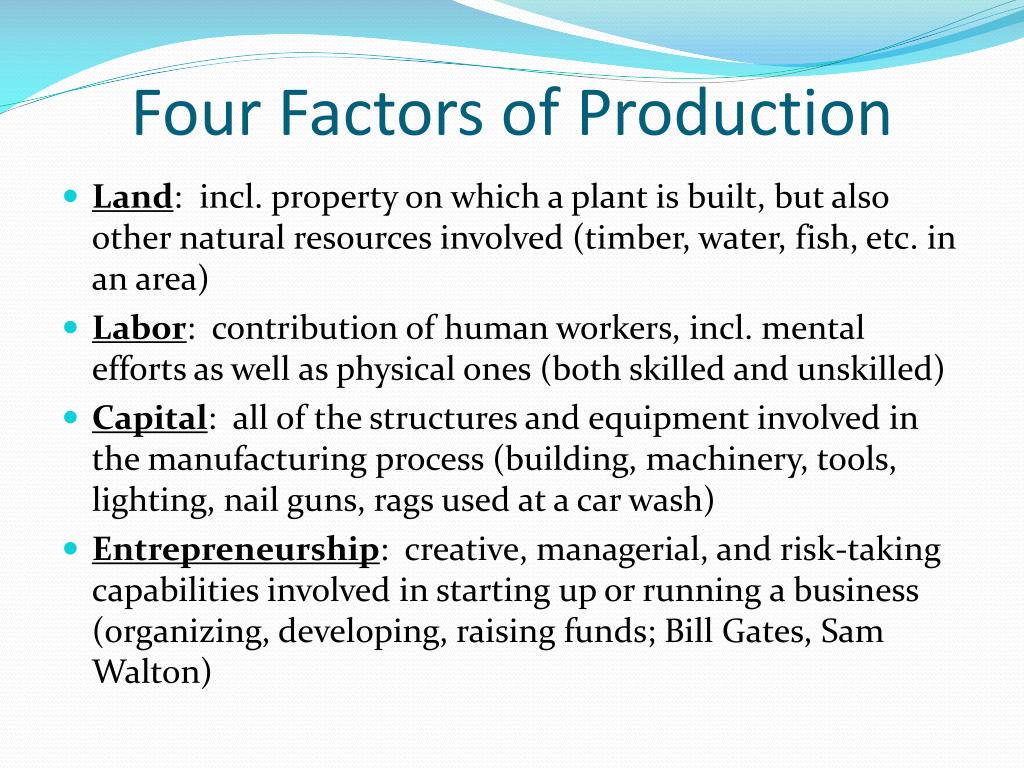

In a modern capitalist economy, businesses often own the land and capital they need to do business. On a small farm in the US, the farmer might own the land and the equipment used to grow crops. All of the other factors of production can be owned by people, groups, corporations, or governments, depending on the economic system. In modern societies, a person's labor cannot be owned by anyone other than the individual. If any of them were missing, nothing could be produced and the economy would grind to a halt. In the end, all of the factors of production are important. But what is the value of an idea without a way to bring it to life? After all, innovation is the heart of all business, and trailblazers are responsible for all technological advancement. And capital is static without human ingenuity.Ĭonsequently, entrepreneurship is sometimes considered the most vital factor of production. Of course, one might point out that you can’t have machinery (capital) without the materials (land) to make it. Capital enhances the other factors, and it can increasingly replace labor completely. Others might argue that capital is the most critical factor. However, automation is increasingly replacing the need for workers.

For example, German philosopher Karl Marx puts human effort squarely at the center of economic production - with materials acting as the object of labor and equipment acting as its instrument. Therefore, you could argue that labor is the most crucial factor of production.
#4 FACTORS OF PRODUCTION SOFTWARE#
However, professional services and software are increasingly important in the modern economy.

One could argue that land is most important, since all physical products originate from the resources it provides. And an entrepreneur must combine all of the above in new ways and get products to customers.

Those people can’t accomplish their work without tools and equipment (capital). Those materials can’t be extracted, refined, and transformed without people working (labor). No product can be made without raw materials (land). The income owners of capital earn is called interest.Īll of the factors of production contribute to economic growth. Equipment can also replace labor entirely through automation. For example, it might take 10 people an hour to dig a hole that one person with a backhoe can dig in five minutes. Tools can make workers more productive, reducing the need for labor. It is worth noting that capital is commonly a substitute for labor. Other forms of capital described in the field of microeconomics - such as social capital (benefits from relationships and networks) or human capital (education and technical skills) - also fall outside the scope. In general, working capital and financial capital don’t fall under the definition of capital as a factor of production. That contrasts with the term “ working capital ,” which is a financial measure of a company's liquid assets. It usually gets tracked as property, plant, and equipment (PP&E) on a company’s balance sheet. In accounting, a capital asset must be depreciated (the value of the asset erodes over time on the company’s books) over its useful life. Things built with the end-user in mind are called consumer goods, whereas items created to produce other products are called capital goods.Ĭapital, often called fixed capital, tends to be durable and used by a business over several years. Altogether, a finished product can represent the efforts of thousands of workers transforming materials into incrementally higher-value products. For example, buildings are made of wood, steel, concrete, and other construction materials that are assembled with labor and equipment. Money is used to purchase those things, but it’s not used directly to make products.Ĭapital is itself a product of other factors of production. Buildings, office equipment, machinery, and software programs are considered capital. As a factor of production, capital refers to all the tools and equipment used in the process of making other goods. Although “ capital ” in business and economics often refers to financial capital (money), that’s not the case here.


 0 kommentar(er)
0 kommentar(er)
